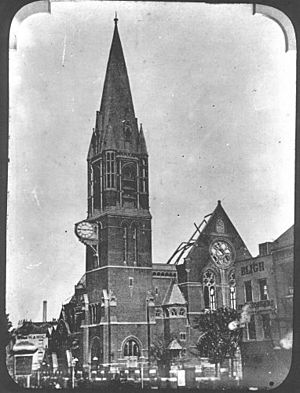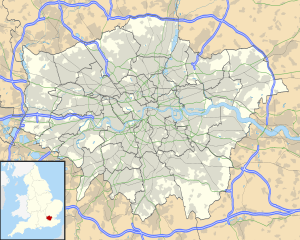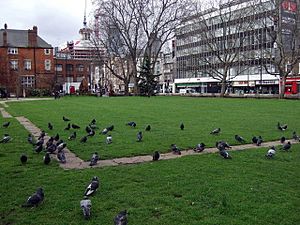St Mary Matfelon facts for kids
Quick facts for kids St Mary's, Whitechapel |
|
|---|---|
| St Mary Matfelon Church, Whitechapel | |

St Mary's Church, Whitechapel,
after the fire in 1880 |
|
| 51°30′59″N 0°04′07″W / 51.5163°N 0.0686°W | |
| Location | Whitechapel, London |
| Country | England |
| Denomination | Church of England |
| History | |
| Status | parish church |
| Architecture | |
| Functional status | defunct |
| Completed | 1329 |
| Administration | |
| Deanery | Tower Hamlets |
| Archdeaconry | Stepney |
| Diocese | London |
| Province | Canterbury |
St Mary Matfelon, better known as St Mary's, Whitechapel, was a famous Church of England parish church in London. For a long time, people believed the area of Whitechapel got its name from this church. The story goes that the church was painted with a white lime whitewash, making it a bright landmark known as the "white chapel."
The church was first built around 1329. It was rebuilt several times over the centuries. Sadly, the final building was destroyed during the Blitz, a bombing campaign in World War II. It was taken down in 1952. Today, a park called Altab Ali Park sits where the church once stood. You can still see the stone outline of the church on the ground.
Contents
The History of St Mary's Church
A church stood on this spot in London for over 670 years. The very first version was a small chapel called the "white chapel." It was built as a "chapel-of-ease," which is a smaller church for people who lived too far from the main parish church in Stepney.
By 1320, the chapel had become the center of its own parish, which is a church district. It was given the official name St Mary Matfelon. No one is completely sure where the name "Matfelon" came from. One idea is that it was the last name of a person who helped build or fund the church. A wine merchant named Richard Matefelun lived in the area in the 1200s.
A Controversial Event
In 1511, a local man named Richard Hunne had a disagreement with the church's priest. He was arrested and put on trial for heresy, which meant having religious beliefs that went against the church's official teachings. While waiting for his trial, Hunne was found dead in his cell under mysterious circumstances.
Rebuilding the Church
The church was rebuilt several times. A major rebuilding project was finished in 1877, paid for mostly by a Member of Parliament named Octavius Coope.
Just a few years later, on August 26, 1880, a fire badly damaged the new church. Only the tower and a few rooms survived. But it was rebuilt again and reopened in 1882. This new version could hold 1,600 people and even had a pulpit outside for giving sermons. Some of these sermons were given in Yiddish for the local Jewish community.
The End of the Church
During World War II, London was heavily bombed by the German Air Force, the Luftwaffe. On December 29, 1940, a firebomb raid destroyed St Mary's. The ruins were left standing for over a decade until they were finally demolished in 1952.
The land was turned into a public park, now called Altab Ali Park. The stone footprint of the church was preserved, so visitors can see exactly where the historic building once stood. Several notable people were buried in the church's graveyard over the centuries, including the philanthropist Sir John Cass.
Why Was It Called the 'White Chapel'?
The most popular theory for the name "Whitechapel" is very simple. In the Middle Ages, the original church was painted with whitewash, a type of paint made from lime and chalk. This gave the building a bright white color.
Because the church was on a main road, it was a well-known landmark. People started calling it "the white chapel," and soon the entire neighborhood became known as Whitechapel.
The Controversial Altarpiece of 1713
In the early 1700s, England's politics were very divided. The two main groups were the Whigs and the Jacobites. The rector of St Mary's, Richard Welton, was a strong supporter of the Jacobites.
Around 1713, Welton ordered a new altarpiece for the church. An altarpiece is a work of art placed behind the altar. This one showed the Last Supper, the final meal Jesus shared with his apostles. But Welton had the artist, James Fellowes, paint the faces of his political enemies onto the figures.
The apostle Judas Iscariot, who betrayed Jesus, was painted to look like a Whig church leader named Dean White Kennett. Another apostle, John the Apostle, was made to look like Prince James Edward, the Jacobite leader.
Many people came to see the painting. When Dean Kennett's wife saw it, she was very angry to see her husband portrayed as a traitor. Kennett complained to the Bishop of London, who ordered the altarpiece to be removed in 1714.



